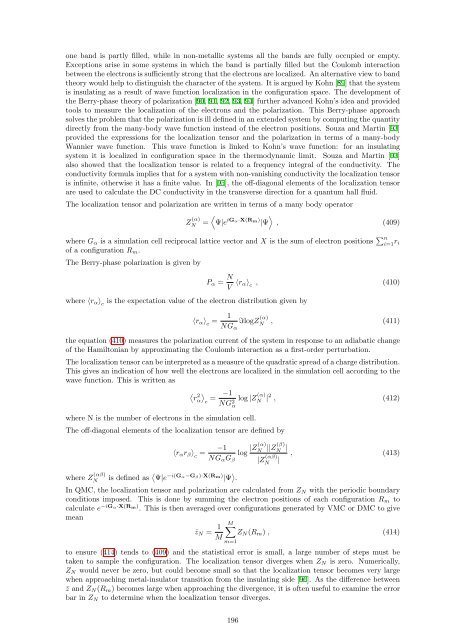CASINO manual - Theory of Condensed Matter
CASINO manual - Theory of Condensed Matter
CASINO manual - Theory of Condensed Matter
You also want an ePaper? Increase the reach of your titles
YUMPU automatically turns print PDFs into web optimized ePapers that Google loves.
one band is partly filled, while in non-metallic systems all the bands are fully occupied or empty.<br />
Exceptions arise in some systems in which the band is partially filled but the Coulomb interaction<br />
between the electrons is sufficiently strong that the electrons are localized. An alternative view to band<br />
theory would help to distinguish the character <strong>of</strong> the system. It is argued by Kohn [89] that the system<br />
is insulating as a result <strong>of</strong> wave function localization in the configuration space. The development <strong>of</strong><br />
the Berry-phase theory <strong>of</strong> polarization [90, 91, 92, 93, 94] further advanced Kohn’s idea and provided<br />
tools to measure the localization <strong>of</strong> the electrons and the polarization. This Berry-phase approach<br />
solves the problem that the polarization is ill defined in an extended system by computing the quantity<br />
directly from the many-body wave function instead <strong>of</strong> the electron positions. Souza and Martin [93]<br />
provided the expressions for the localization tensor and the polarization in terms <strong>of</strong> a many-body<br />
Wannier wave function. This wave function is linked to Kohn’s wave function: for an insulating<br />
system it is localized in configuration space in the thermodynamic limit. Souza and Martin [93]<br />
also showed that the localization tensor is related to a frequency integral <strong>of</strong> the conductivity. The<br />
conductivity formula implies that for a system with non-vanishing conductivity the localization tensor<br />
is infinite, otherwise it has a finite value. In [95], the <strong>of</strong>f-diagonal elements <strong>of</strong> the localization tensor<br />
are used to calculate the DC conductivity in the transverse direction for a quantum hall fluid.<br />
The localization tensor and polarization are written in terms <strong>of</strong> a many body operator<br />
〉<br />
Z (α)<br />
N<br />
〈Ψ|e = iGα·X(Rm) |Ψ , (409)<br />
where G α is a simulation cell reciprocal lattice vector and X is the sum <strong>of</strong> electron positions ∑ n<br />
i=1 r i<br />
<strong>of</strong> a configuration R m .<br />
The Berry-phase polarization is given by<br />
P α = N V 〈r α〉 c<br />
, (410)<br />
where 〈r α 〉 c<br />
is the expectation value <strong>of</strong> the electron distribution given by<br />
〈r α 〉 c<br />
= 1<br />
NG α<br />
IlogZ (α)<br />
N , (411)<br />
the equation (410) measures the polarization current <strong>of</strong> the system in response to an adiabatic change<br />
<strong>of</strong> the Hamiltonian by approximating the Coulomb interaction as a first-order perturbation.<br />
The localization tensor can be interpreted as a measure <strong>of</strong> the quadratic spread <strong>of</strong> a charge distribution.<br />
This gives an indication <strong>of</strong> how well the electrons are localized in the simulation cell according to the<br />
wave function. This is written as<br />
where N is the number <strong>of</strong> electrons in the simulation cell.<br />
The <strong>of</strong>f-diagonal elements <strong>of</strong> the localization tensor are defined by<br />
〈<br />
r<br />
2<br />
α<br />
〉c = −1<br />
NG 2 log |Z (α)<br />
N |2 , (412)<br />
α<br />
〈r α r β 〉 c<br />
= −1 log |Z(α) N<br />
||Z(β) N |<br />
NG α G β |Z (αβ)<br />
N | , (413)<br />
where Z (αβ)<br />
N<br />
is defined as 〈 Ψ|e −i(Gα−G β)·X(R m) |Ψ 〉 .<br />
In QMC, the localization tensor and polarization are calculated from Z N with the periodic boundary<br />
conditions imposed. This is done by summing the electron positions <strong>of</strong> each configuration R m to<br />
calculate e −iGα·X(Rm) . This is then averaged over configurations generated by VMC or DMC to give<br />
mean<br />
¯z N = 1 M∑<br />
Z N (R m ) , (414)<br />
M<br />
m=1<br />
to ensure (414) tends to (409) and the statistical error is small, a large number <strong>of</strong> steps must be<br />
taken to sample the configuration. The localization tensor diverges when Z N is zero. Numerically,<br />
Z N would never be zero, but could become small so that the localization tensor becomes very large<br />
when approaching metal-insulator transition from the insulating side [96]. As the difference between<br />
¯z and Z N (R m ) becomes large when approaching the divergence, it is <strong>of</strong>ten useful to examine the error<br />
bar in Z N to determine when the localization tensor diverges.<br />
196

















